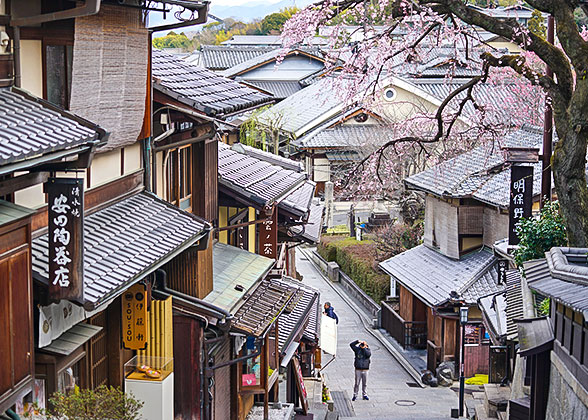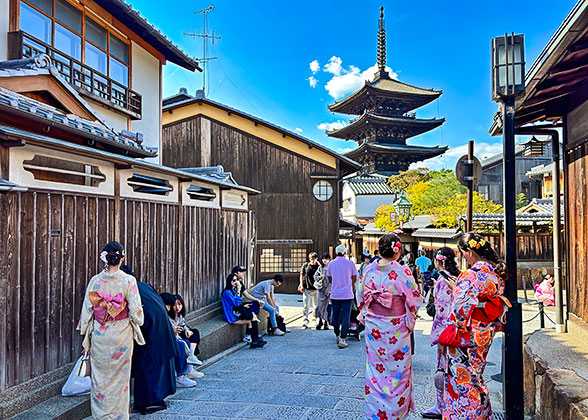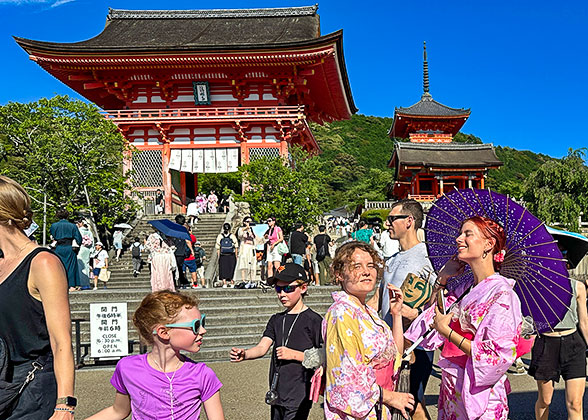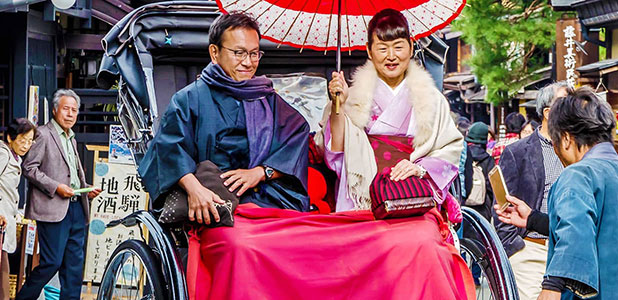Ninenzaka and Sannenzaka
Visiting Kyoto, the ancient capital of Japan (from 794 to 1868), without taking a stroll through its Ninenzaka and Sannenzaka sloping streets would be a lifetime of regret. Lying in the city’s eastern historical district of Higashiyama, they lead to the UNESCO-preserved ancient Kiyomizudera Temple (Pure Water Temple). Built over 1,200 years ago after the temple, lined with traditional Japanese buildings servings as shops, ryokan (Japanese-style inn), and cafés on either side, these atmospheric lanes offer some best chances to experience local traditional culture.

|
Quick Facts of Ninenzaka and Sannenzaka
|
|
|
What to Expect at Ninenzaka and Sannenzaka?
![]() This area provides an authentic feel of Kyoto’s ancient past. The streets themselves, and the surrounding ancient landmarks such as Kiyomizudera Temple, Yasaka-no-to Pagoda, Yasaka Shrine, and Maruyama Park, all contribute to it.
This area provides an authentic feel of Kyoto’s ancient past. The streets themselves, and the surrounding ancient landmarks such as Kiyomizudera Temple, Yasaka-no-to Pagoda, Yasaka Shrine, and Maruyama Park, all contribute to it.
|
|
|
![]() Ninenzaka offers the best angle to capture the solitary grace of Yasaka-no-to Pagoda, five-storied and sitting on a hill. Even more spectacular at night, it’s no doubt a symbol of Higashiyama district.
Ninenzaka offers the best angle to capture the solitary grace of Yasaka-no-to Pagoda, five-storied and sitting on a hill. Even more spectacular at night, it’s no doubt a symbol of Higashiyama district.

Graceful Yasaka-no-to Pagoda
|
|
|
|
![]() Pick a ryokan – traditional Japanese-style inn - to settle yourself in. Some ryokans are converted machiya townhouses, traditional wooden residences and workplaces of the Edo-era Kyoto merchants that survived to this day intact.
Pick a ryokan – traditional Japanese-style inn - to settle yourself in. Some ryokans are converted machiya townhouses, traditional wooden residences and workplaces of the Edo-era Kyoto merchants that survived to this day intact.
|
|
|
How to Get There?
By bus: From Kyoto Station, take City Bus No. 206 to Kiyomizu-michi Bus Stop, and walk about 5 minutes.By train: Take Keihan Line, get off at Kiyomizu-Gojō Station, and walk about 20 minutes.
Nearby Must-Visits
![]() Kiyomizu-dera Temple (At the eastern end of Sannenzaka street)
Kiyomizu-dera Temple (At the eastern end of Sannenzaka street)
Escaping into the quiet Zen world of the 800-year-old Kennin-ji from the busy Ninenzaka and Sannenzaka would be fascinating. There are typical “dry landscape” gardens, which use gravel and rocks to represent our universe, and treasured paintings to appreciate.
Out from Kennin-ji Temple, visitors will enter the Hanami-koji Street of Gion area, the No.1 place in Japan to spot geishas walking to ancient ochaya teahouses to work. After dinner, visitors can stop by the southern Gion Corner on the street to watch authentic traditional art performances, including maiko dances.
Yasaka Shrine is often called Gion Shrine by locals. The shrine has a special place in Japan, not only because it’s where Japan’s most celebrated Gion Festival originated, but also what the said Gion area got its name from.
Precisely, Sanjusangendo is the main hall of a temple whose other buildings have all been destroyed during over 800 years of history. It strikes the world with its wooden structure, the longest in the world, and 1,001 statues of thousand-armed Kannon stored within.
Ninenzaka and Sannenzaka Photos & Videos




